Jue, Ene 5th 2023

Fondue is the national dish of Switzerland, but most outsiders do not realize that the Swiss only eat it in winter.
Fondue is both a meal and a ceremony, oft lauded as a national treasure and sometimes panned as nothing more than a dish to use up stale bread. Synonymous with winter and typically enjoyed as a cold-weather feast, there is nothing like sitting around a bubbling caquelon, long forks at the ready, waiting to submerge pieces of bread into the gooey mix of molten cheese while wafts of kirsh tickle your nose.
The origins of fondue date back centuries, with the earliest mention of it recorded in a Swiss cookbook from 1699: Kochbuch der Anna Margaretha Gessner. In 1875, almost two hundred years later, the modern recipe of fondue was promoted as a Swiss national dish in order to unite the different regions of Switzerland around a common theme: cheese. While specific details on where exactly fondue originated within Switzerland are unsurprisingly hazy, some cookbooks from the 20th century indicate that Neuchâtel and other French-speaking parts of the country are where its roots can be found. However, it wasn’t until the 1930s that the Schweizer Käseunion (the Swiss Cheese Union) stepped in and amped up the status of the lowly fondue in an effort to increase cheese consumption and sustain the nation’s dairy industry.
Fondue varies depending on where in Switzerland you sample it. Its flavorings can range from pungent kirsch (cherry brandy) to the best local white wines, from garlic and chili to truffles and tomato, from chunks of bread pronged on those long fondue forks to cubed potatoes, sweet pineapple, and glistening pearls of pickled onions (to cut the sweetness of the fondue). And that’s before we even get started on the cheese.
The most traditional cheese combination is the moitié–moitié (half and half) of Gruyère and Vacherin Fribourgeois, with the excellent melting-cheese Vacherin that many believe crucial to prevent the fondue from ‘breaking’. As well as this combination, you have the neuchâteloise (Gruyère and Emmental), the vaudoise (Gruyère), the fribourgeoise (Vacherin Fribourgeois), and the Fondue de Suisse centrale (Gruyère, Emmental, and Sbrinz), among countless other recipes. So read on for the lowdown on the country’s best fondue (in no particular order).
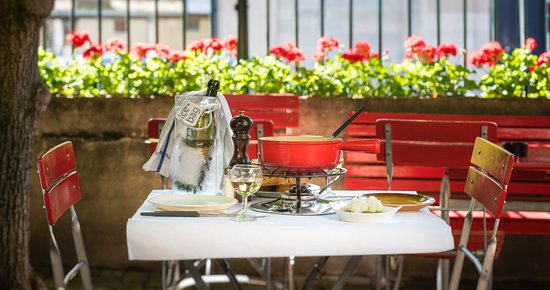
Café du Soleil in Geneva.
This authentic Genevan bistrot is rich in superlatives: it is one of the oldest restaurants in Geneva with more than 400 years under its belt, and it boasts one of the best fondues in the city (if not the world). When the local Genevois people want fondue, they come here. The café’s legendary fondue is the vaudoise variety, made with one kind of cheese – Gruyère – from the village of La Roche, in the Gruyère district of Fribourg. Served with hearty chunks of fresh bread and excellent local wine (choose a fruity one for a magical pairing), this rich and creamy fondue is simply out of this world. The café itself is warm, cosy, and relaxed, with mismatched furniture and a family ambiance that will have you feeling instantly at home. It’s always best to reserve a table in advance, as this place fills up fast.
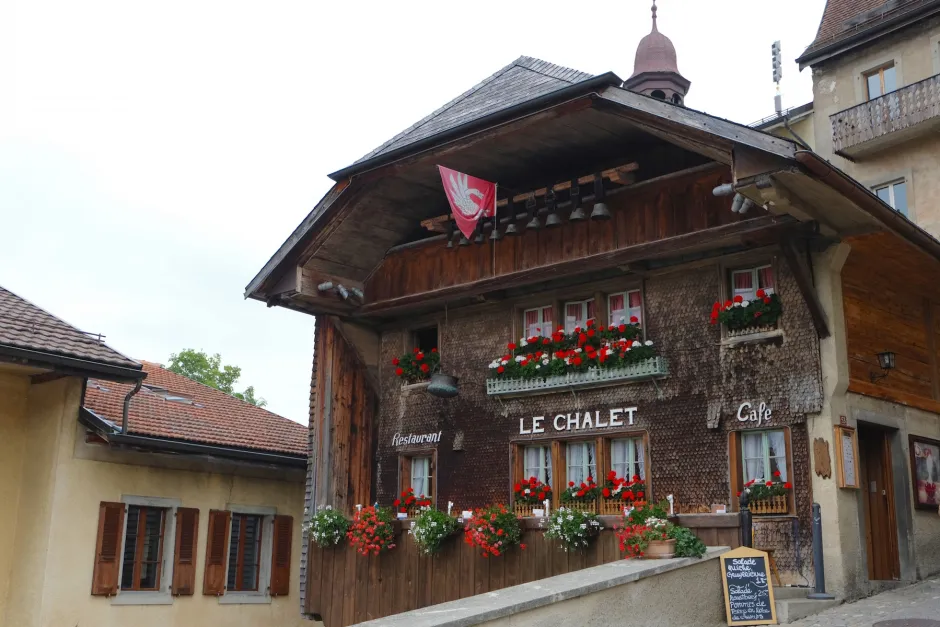
Le Chalet de Gruyères in Gruyères (credit: Michelle Franc-Lee).
There can’t be a best-of list for fondue without going to the source itself: Gruyères. Le Chalet de Gruyères is an iconic restaurant that uses the best of the surrounding region to create truly delicious fare. Almost all of the dishes featured on the menu are made with products from local cheesemakers, butchers, bakers, and distilleries. This cosy chalet, with its copper pots twinkling from the rafters, is the perfect place to sample the perfect fondue. The Château de Gruyères fondue is served all year-round, but the special winter fondue is a must. Made with Vacherin Mont-d’Or cheese from the Vaud town of Jura, this distinctive soft cheese has been produced by hand for over a century and is renowned for its firewood belt and creamy flavor. The fondue is served alongside a wooden pepper mill for a peppery addition, a dish of delicate pearl onions, and a steaming basket of boiled potatoes, tucked under a gingham blanket to stay warm. Nothing more is needed.
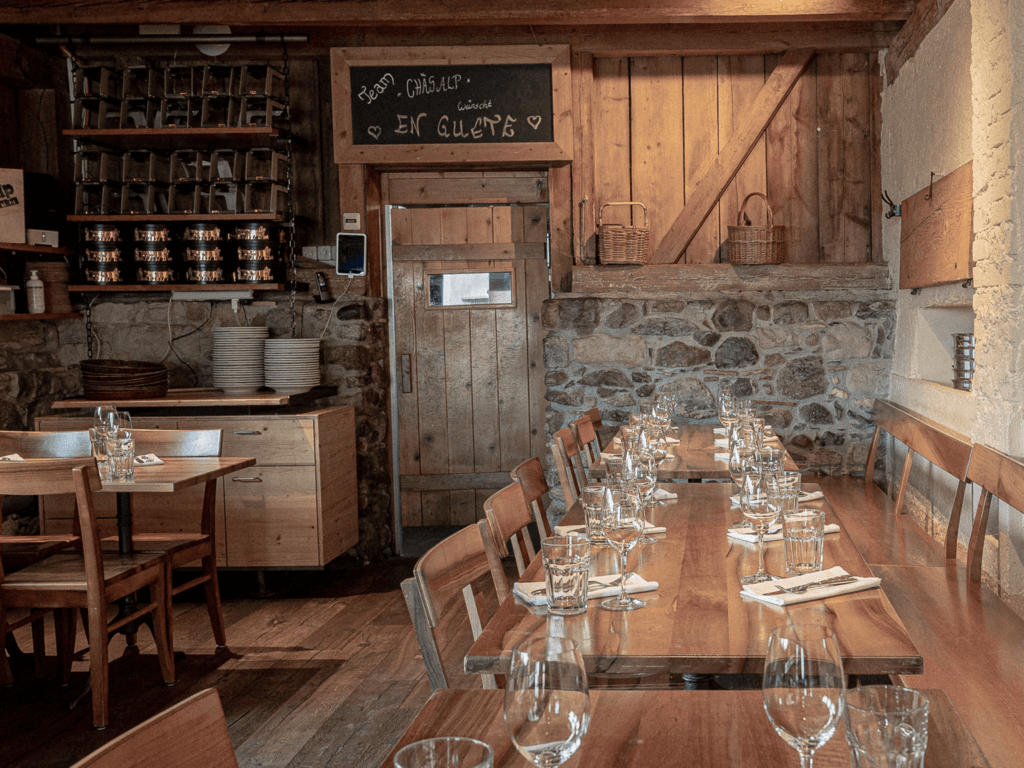
Chäsalp in Zürich.
This unassuming converted cowshed is regularly featured on the best fondue lists of Zürich. Chäsalp (meaning Cheese Alp) is located on the Zürichberg, a wooded hill to the east of the city, overlooking the fabulous vista of Lake Zürich and the Swiss Alps. Following a tram to the Zürich Zoo, it’s a twenty-five minute walk through the woods to get here, but it’s worth every step. The restaurant is housed in an old cowshed on Alter Tobelhof farm and has seven hundred years of history between its quaint walls. It serves fifteen variations of cheese fondue, with flavorings ranging from chili and peppercorn to apple, mushroom, and champagne. You can also avail of the ‘Fondue Feast’, where you can sample eight different types of fondue. We recommend booking ahead, and if you can, reserve a spot on the garden terrace to watch the sunset over Lake Zürich, fondue fork in hand.
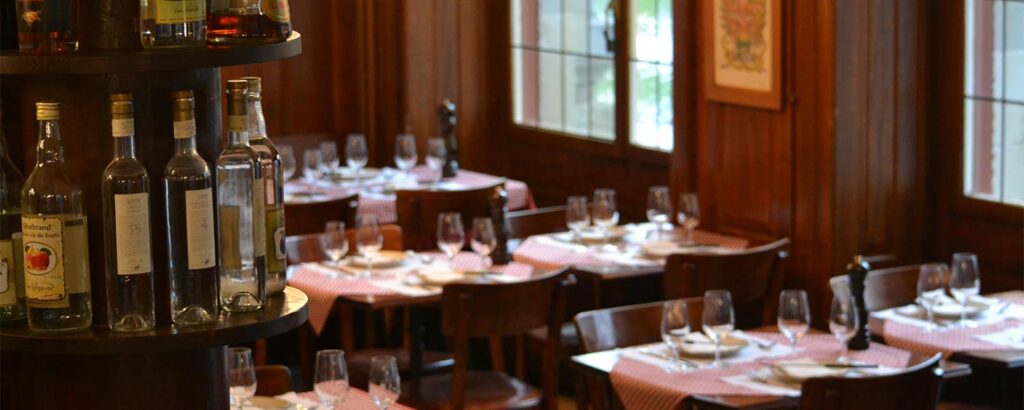
Fribourger Fonduestübli in Zürich.
This cosy restaurant has been a stalwart of Zürich’s ever-changing gastro scene for over forty years, with owner Denise Schmutz taking over the business from her mother before her. Loved by locals, it has been serving some of the best fondue since 1975, and although it’s right in Zürich’s buzzing and modern city centre, step inside and you’ll soon feel like you’ve been whisked away to the mountains – with red gingham tablecloths, ornate lamps, wooden furnishings, and the familiar, cloying smell of melted cheese, this is old-world charm at its best. The Fribourger serves nothing but fondue, and specializes in two types: the moitié–moitié of Gruyère and Vacherin Fribourgeois, and the fribourgeoise of Vacherin Fribourgeois. Wash whichever delicious flavor you choose down with a sweet glass of Swiss schnapps and enjoy the endless struggle of trying to keep those pesky pieces of pear and pineapple on the fondue fork without losing them in the pot.
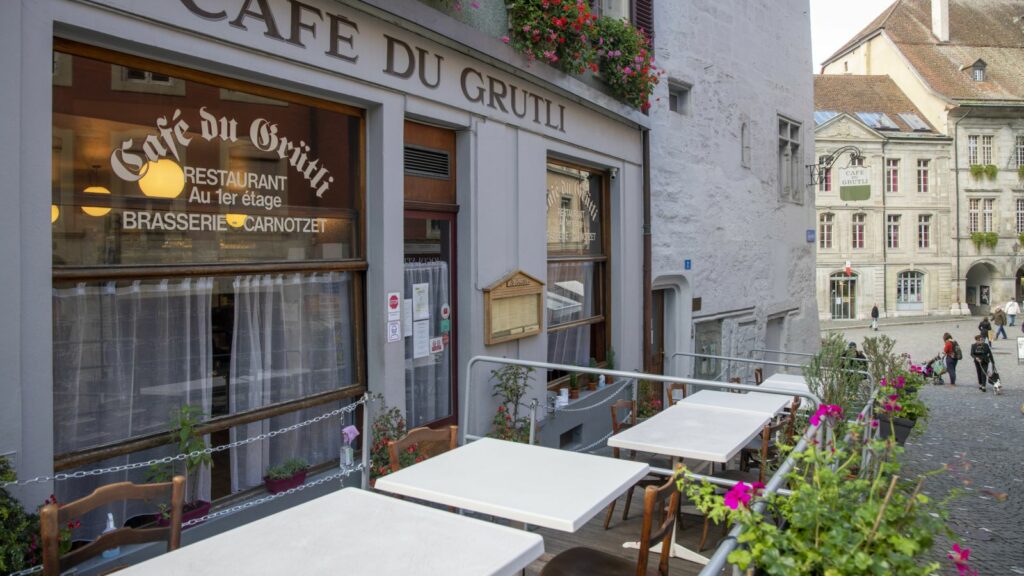
Café du Grütli in Lausanne.
Café du Grütli was awarded the ‘Café historique de Lausanne’ label in 2021 and has been situated in the middle of the Altstadt (Oldtown) of Lausanne since 1849. The café is in a turquoise Wes Anderson-style building (dating from the fourteenth century) that teeters up from the narrow, paved alley beneath to give the Grand Budapest a run for its money. Family owned and loved by locals and tourists alike, each dish is prepared with the best from the region and the best from the market, all according to the season. Nab a seat in one of the cable cars out front and enjoy the chiming of the old clock on the Place de la Palud as you enjoy the delectable fondues on offer, made with the best Gruyère, garlic, and local white wines.
Este artículo puede compartirse y reimprimirse libremente, siempre que se incluya un enlace al artículo original.
